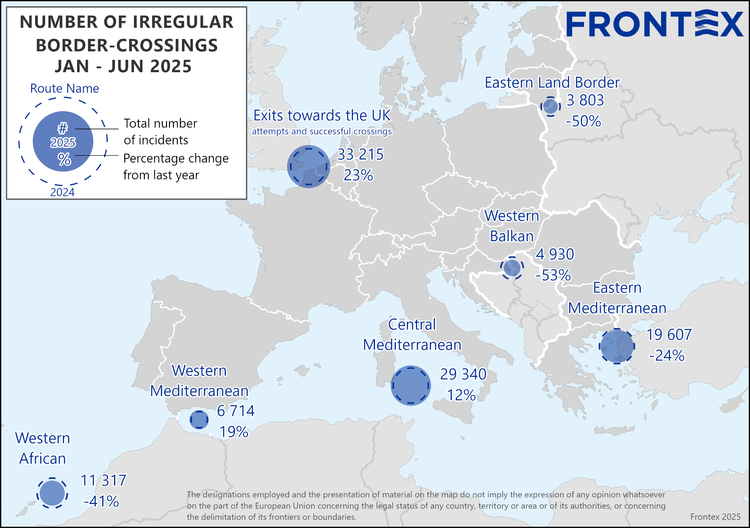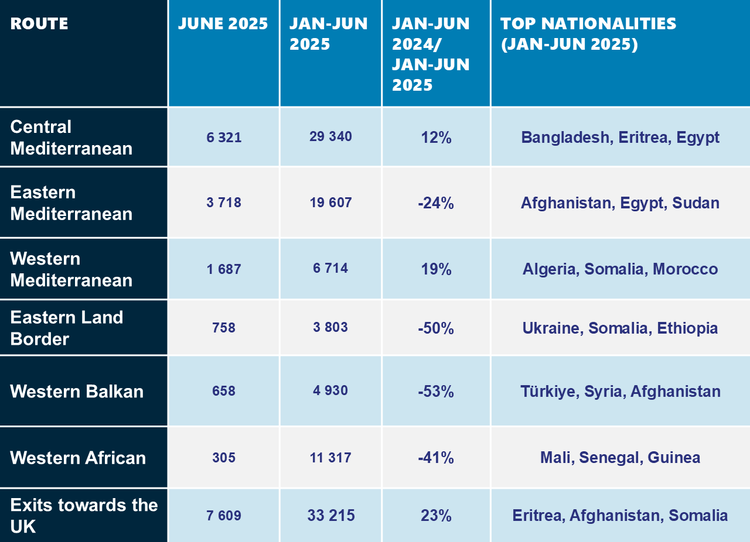In the first half of 2025, irregular crossings into the
European Union fell by 20% to 75 900 thanks to significant drops in the Eastern
Mediterranean and West African routes, according to preliminary figures collected
by Frontex*.
While the overall numbers are down, pressure remains high on
the Central Mediterranean, and new migration corridors continue to emerge.
With 3 000 Frontex officers working alongside national
authorities, the EU remains committed to protecting its borders and saving
lives at sea.
Crossings via the Eastern Mediterranean migratory
route dropped by nearly a quarter to 19 600. Nevertheless, the route has seen a
notable development in recent months with the emergence of the Libya-Crete
corridor. This corridor now accounts for the largest number of crossings in
the Eastern Mediterranean.
Despite the overall decline across the EU, the Central
Mediterranean route saw more than 29 300 irregular crossings, 12% more than
in the same period in 2024.
Libya continues to be the main country of departure for
these dangerous journeys, with some 20 800 migrants arriving in Italy,
reflecting an 80% surge from last year.
Another route that saw a rise was the Western
Mediterranean route, where arrivals increased by 19% compared to the first
half of 2024. In June alone, the number of arrivals on this route doubled
compared to the same month last year.
Algeria remains the primary departure country on the route with
roughly 80% increase from 2024, indicating that smuggling networks are adapting
their activities and increasingly using alternative routes from North Africa.
In contrast, the Western African route recorded a
significant decrease. Arrivals dropped by over 40%, with 11 300 detections in
the first six months of this year and only 300 crossings reported in June.
This downward trend is largely due to stronger prevention
efforts by departure countries working in close cooperation with EU Member
States to address irregular migration at its source.
Behind these numbers lie tragic human stories as many
migrants undertake perilous sea journeys in overcrowded, unseaworthy vessels,
risking their lives to cross the sea. According to the International
Organization for Migration estimates, 760 people lost their lives in the
Mediterranean in the first six months of this year alone.
Meanwhile, on the Channel route, migrant attempts to
cross into the United Kingdom rose by 23%, reaching 33 200 attempts between
January and June. The rise has been driven by a variety of factors, including a
much higher number of days with good weather conditions this year, the rising
use of “taxi boats” that evade detection and more people crammed on individual
boats. Despite enforcement
efforts the route is still seen as viable by smuggling groups that remain
active and adapt quickly, without much care about the safety of the migrants.
* Note:
The preliminary data presented in this statement refer to the number of
detections of irregular border crossing at the external borders of the European
Union. The same person may cross the border several times in different
locations at the external border.

